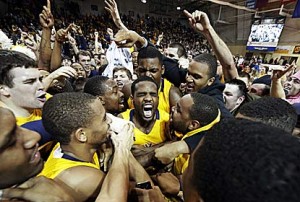Good…Better…Best Practices
Posted by Laura Otten, Ph.D., Director on March 22nd, 2013 in Thoughts & Commentary
0 comment
La Salle Basketball NCAA Nielson Ratings NIT Nonprofit Best Practices
And so it is true with best practices and nonprofits: there are best practices, those practices to which everyone who wants to be the best will aspire. They are beacons to right organizations if and when they may have lost their ways. But, it is also true that not every nonprofit has the ability, interest, drive, capacity, etc., to implement and sustain best practices. Still, every nonprofit should and must have the capacity to be on the good-better-best continuum working in the direction toward best. To do otherwise suggests quite loudly that the organization does not care by what principles it comports itself, that ends justify means, and that improvement is not of value.
Don’t we all need something to which to aspire? La Salle University’s basketball team just squeaked into the field of 68 teams for this year’s NCAA tournament (first time since 1992). Folks were confident that if La Salle didn’t make the NCAA it would be one of the 32 teams invited to the NIT.
(The NCAA is more prestigious—the best end of the continuum; the NIT is just in the better slot, despite being the older sibling.) Before the selection was made last Sunday, I had several discussions with college basketball aficionados as to whether it would better to get into the NIT where it was likely the team could go further into the playoffs than get into the NCAA and, in all likelihood, not get as far. As you might imagine, I had advocates for both positions: it is more advantageous to be the best, even if for a short while, while others thought better was good enough, especially if it was likely that you could survive in that tournament longer, regroup, come back stronger next year, and then get to the NCAA and truly be competitive.
Let’s follow this through a little further. What are the consequences to those teams and schools that get to compete in the NCAA versus the NIT tournaments? High school players want to play where? The schools that are regularly in the NCAA. Why? Because they are supposed to be the “best”. Will they settle for teams that were just in the NIT? You bet, and quite happily over a school that didn’t even get an invitation to any of the big dances. How about the sponsors? Where do you think they want their money to go? My Google search discovered that last year’s NCAA final game received a 12.1 Nielsen rating (albeit down 9% from 2011); it did not produce a statistic for the Nielsen rating for the NIT final game.
The point is that there are best practices—notice the plural there—that have been deemed, based on evidence, to lead to success with a greater consistency and frequency than other practices. Nowhere in the term of best practices—see the plural, though, is it suggested that there is one and only one model. Nor does it mean that if you aren’t abiding by best practices you aren’t worth watching; you just aren’t deemed the best. Which means that if you don’t have the capacity, the drive, the talent, the interest, in playing with the big dogs, that is fine; stay where you can comfortably reside, doing as well as you can within your means. But don’t settle for staying there if you want or need the rewards of moving down that good-better-best continuum.
To suggest to nonprofits that there are no best practices in our sector is to sell ourselves short and give organizations’ a false sense of achievement that, in the end, leaves them short of what might be their potential. To suggest to nonprofits that there are best standards out there, and that while you may not have the organizational capacity to achieve it now, know what it is and what are its rewards, and then decide—proactively and intentionally—if you want to strive for that attainment.
Students who have developed a false understanding of their capabilities—their intelligence, their communication skills, both verbal and written, their critical thinking skills, etc.—and who have been taught that missing deadlines or not adhering to directions will always be forgiven—do not do well in the unprotected world of real life work. That is the effect of grade inflation and dumbing down standards: we give students a grade to give them a false sense of warm and fuzzy about themselves rather than as an indicator of how prepared you are to meet the realities of the world. We do equal harm to nonprofits when we back off best practices and coddle them to think they are just fine where they are. They might be; but they also might be a heck of a lot better—do a much better job of serving out their mission—if we’d stretched their horizons, asked them to risk failure, told them the truth, and asked them to be the best they could be and not settle for mediocre.
The opinions expressed in Nonprofit University Blog are those of writer and do not necessarily reflect the opinion of La Salle University or any other institution or individual.
